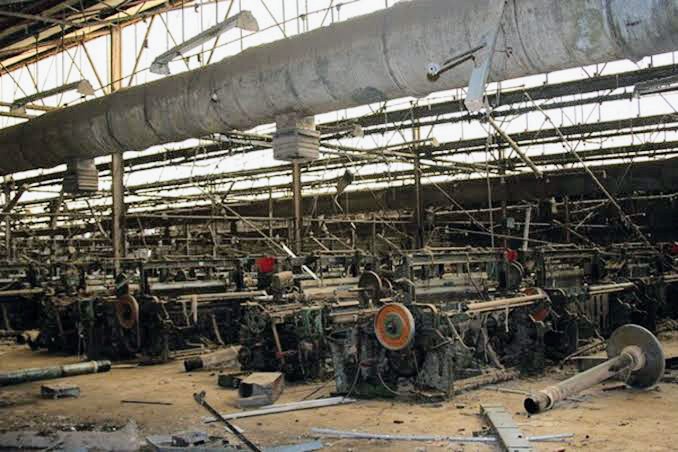Business
FG’s N350bn intervention funds fail to lift textile industry

By AYOOLA OLAOLUWA
The impact of Federal Government’s massive intervention in the textile industry is yet to be felt as virtually all garment making factories operating in the country have remained moribund, BusinessHallmark findings have shown.
According to BH investigation, over N350 billion had being pumped into the sector by successive administrations in an effort to revive it. However, the interventions had failed to lift the sector out of the doldrums.
At the peak of their glory in the late 80s, about127textilefirms scattered across the major industrial hubsin Lagos, Kano, Kaduna, Benin in the old Bendel State and Aba in Abia State were busy churning out African print fabrics into the market.
Prominent amongst them were the Aswani Textile Mills in Isolo, Lagos; United Nigerian Textile Limited, Kaduna; Afprint Nigeria Plc, Isolo, Lagos; Nigerian Textile Mills Plc on Oba Akran Avenue, Ikeja, Lagos; Aba Textile Mills, Abia; Asaba Textile Mills, Delta State; Edo Textile Mills, African Textile Manufacturers Ltd. and Tofa Textile Ltd. in Kano.
However, the tide turned in the 90s with the opening of the nation’s borders to foreign fabrics, expecially from China, Bangladesh and India.
The invasion of cheaper foreign textile materials, coupled with governments’ unfriendly economic policies and worsening power supply led to the collapse of many of the local textile firms.
Their large factories were shut and later taken over by churches and business owners who converted them to worship centres, cinema houses and events centres.
Worried by the sorry state of the industry which at it peak had employed about millions of teeming Nigerian youths and generated billions in revenue to government coffers, successive administrations had tried to kick-start the sector back to life.
In 2007, former President Olusegun Obasanjo launched a N70billion Textile Development Fund (TDF) in a bid to revamp the ailing textile industry.
Speaking during the launch, Obasanjo had stated that the textile sector was the third largest contributor to GDP after oil and agriculture in the country as well as the second largest employer of manpower.
He also assured that when fully revived, the sector will generate at least N60 billion annually and create 200,000 new jobs for the youth. Despite Obasanjo’s passion and assurances to the nation, he could not deliver on his promises.
BH reliably gathered that the funds released to garment manufacturers and cotton farmers were lost and could not be accounted for till the retired army general left office on May 29, 2007.
His successor, former President Umaru Musa Yar’Adua, also made spirited efforts to revive the ailing textile industry. In 2009, Yar’Adua approved the setting up of another N100billion Cotton, Textile and Garment Fund to enable key players to have access to cheap funds.
According to the Bank of Industry(BoI) which managed the fund, majority of the funds were disbursed. However, there is no tangible improvement in the dwindling fortunes of the textile sector.
In December2012, the administration of former President Goodluck Jonathan also injected another N60billion into the nation’s textile industry to revitalise the sector. About a year later, another N40billion was pumped into the sector by the Bank of Industry.
According to Evelyn Oputu, the then managing director of the bank, the fund would help arrest unemployment, boost investment and re-industrialise the fallen sector. In spite of its efforts, the Jonathan administration also failed in its efforts to lift the textile sector.
Undaunted by the failures recorded by his predecessors, President Muhammadu Buhari, immediately he assumed office, pledged his commitment to revitalizing the cotton, garment and textile industry.
According to the president, the sector will employ more Nigerians and also grow the nation’s economy when fully revived.
As promised, the president made the Central Bank of Nigeria (CBN) to release a N50billion special mechanism fund in 2020 to revive the ailing industry.
According to the CBN, the funds were to be administered by the Bank of Industry at 4.5 per cent interest rate, using any of the CBN-approved non-interest instruments for refinancing of projects, long-term financing for the acquisition of plant and machinery and working capital for the beneficiaries.
Beneficiaries can access maximum amount of N2billion (a single oblig or for new facilities) and N1billion for refinancing. The seed fund, a one-off intervention, will terminate on December 31, 2025.
However, just over three years to the termination of the intervention scheme, the number of textile firms in operations is declining, rather than rising as anticipated. According to BH findings, only 20 textile companies are in operations, but struggling to stay a float.
Out of this figure, only three, namely African Textile Manufacturers (ATM) Limited, Angel Spinning and Dyeing Limited, as well as Spinners and Dyers Nigeria Limited are in the real sense textile-producing firms.
The remaining 27 firms that have been able to access the special funds are allied companies in the business of manufacturing towels, rugs, handkerchiefs and other textile related products.
So far, the five administrations since the advent of democracy in 1999 had pumped about N350billion into the failed venture to revive the textile industry, according to BH checks.
The interventions were, however, undone by several factors, including the continued importation of cheaper textile products into the country, and poor power supply.
According to the Nigerian Textile Manufacturers Association (NTMA), Nigerians spend over $4 billion annually importing textiles and ready made clothing.
NTMA’s huge figure was corroborated by the National Bureau of Statistics (NBS) in its latest Commodity Price Indices and Terms of Trade released in April 2022.
According to the NBS, textile finished products were the number one imported product on the country’s import index in 2021.
“The all-commodity group import index on average increased by 0.47 per cent. The highest increase was recorded by textile and textile articles, followed by boilers, machinery and appliances, parts thereof and wood and articles of wood, wood charcoal and articles”, the NBS stated.
Some stakeholders who spoke with our correspondent claimed that over 95 per cent of Nigeria’s textile market is dominated by foreign fabrics.
Apart from the negative effects of influx of imported textile materials into the country, other challenges haunting the textile industry include high cost of production; smuggling and counterfeiting of locally made fabrics, as well as poor patronage of locally made fabrics.
“How can we compete with foreign made textiles while we spend more than half of our production budget on electricity?
“Our major problem is poor infrastructure, especially poor electricity. Our members had to resort to buying diesel and LPFO at very exorbitant rates.
“As if that is not enough, we also battle with other challenges such as high influx of cheap foreign fabrics, high interest rates charged by banks, unavailability of forex and naira depreciation as well as high taxation by government.
“You can imagine how the local textile industry will respond if only 10 percent of the yearly import bill of $4billion on textile fabricsis ploughed into the system”, noted Alhaji Muyiwa Ajao, the chairman of a towel manufacturing company located in Ikeja, Lagos.
Some experts who spoke with BH on the development, while noting that money is not the biggest need of the industry, argued that the Federal Government was just throwing money at the problem, knowing fully it won’t work.
“The government is just behaving like an ostrich that is burying its head in the sands hoping that the problem will go away.
“Without fixing some identified problems like putting a stop to smuggling of foreign fabrics into the country and fixing the challenge of weak infrastructure, especially power, nothing much can be achieved.
“For instance, look at the Executive Order 003 of 2017 signed by President Muhammadu Buhari which made it mandatory for Nigerians, especially government agencies, to patronise locally made textile products.
“The order has remained active on paper as Ministries, Departments and Agencies (MDAs) of government still import their uniforms from abroad despite local capacity for such apparels.
“Even schools are guilty of the crime. If you check the collars of the uniforms worn by students of big private schools, you will find out that virtually all of them are made in England by Zeco.
“We are talking of millions of students who have at least two pairs of uniforms. Just imagine if Nigerian garments manufacturers are getting just half of the order, we won’t be in this kind of mess”, lamented the proprietor of a garment company in Ibafo, Ogun State.
Also speaking, the President of the Nigerian Textile Manufacturers Association (NTMA), Mr. Folorunsho Daniyan, said the nation’s textile industry is on the verge of collapse.
“Ordinarily, the year marking our 65th anniversary (which is this year) should have been time for celebration and popping of champagnes.
“But this, sadly, is not our situation. If the truth must be told, our industrial sector is dying and needs urgent interventions from the federal government to keep it alive.
“Our membership has shrunk from 175 textile industrial firms in 1985 to less than 20 currently in 2022.
“Employment-wise, the number of jobs provided by the industry took a dive from 137,000 jobs in 1996 to 24,000 jobs in 2008. Today the number of jobs provided in the industry is less than 20,000 jobs.
“This is sad for an industrial sector that was once adjudged the highest employer of labour in Nigeria after the federal government in the 1980s when it had 500,000 workers under its employment.
“We had the revival loans but these didn’t work because our biggest problem has never been money.
“What we need is the enabling environment. We cannot compete with the level of smuggling and counterfeiting going on now,“ he said.
An investment consultant and director at the Lagos Chamber of Commerce and Industry (LCCI), Dr. Vincent Nwani, said none of the interventions introduced by successive administrations trickled down or had been able to lift the textile sector from its moribund state due largely to poor monitoring, implementation lapses and official corruption.
“For now, it is very difficult to find a textile company that produces 90 metre or more length for bedding in Nigeria,” Nwani noted.


